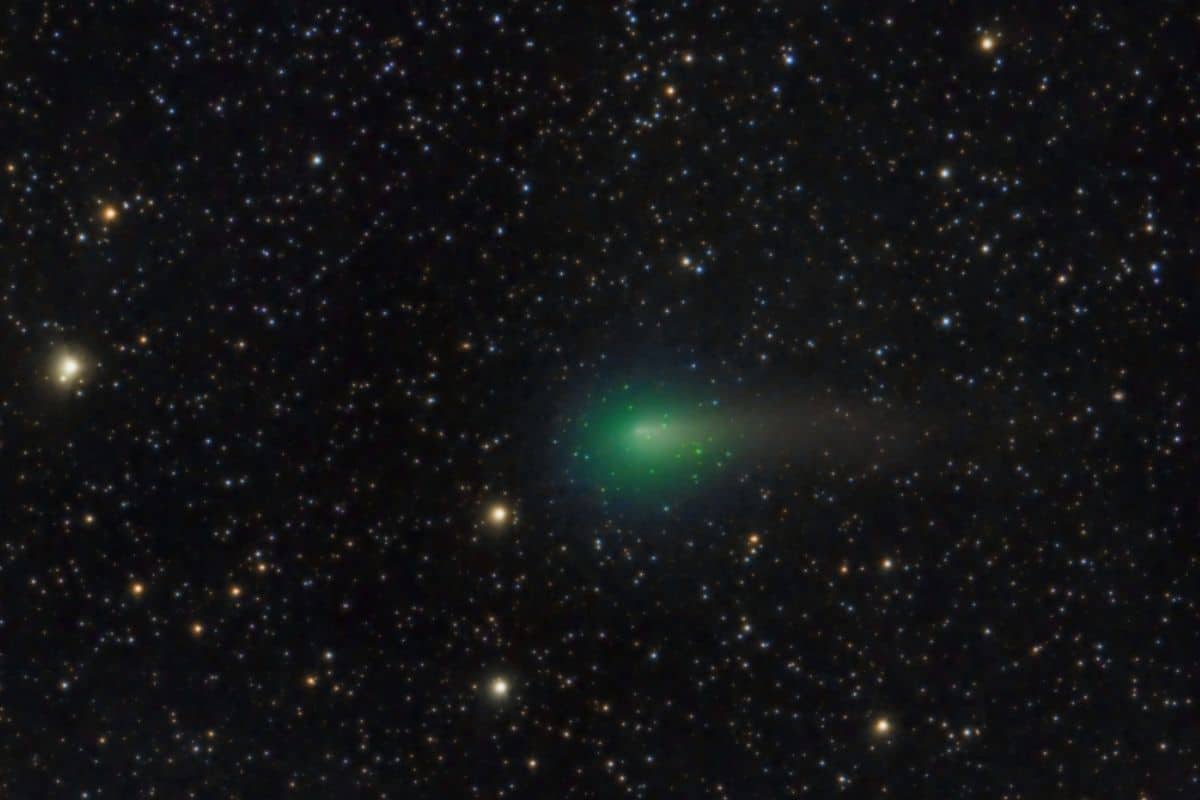
The ‘head’ of a comet sometimes turns green, but the tail never. And now we finally know why.
For nearly a century, astronomers have grappled with a persistent mystery. The ‘head’ of some comets sometimes turns green. But the tail? That never. Nobody understood why. But now scientists claim to have finally cracked the code.
Green
From time to time, the Kuiper Belt and the Oort Cloud throw galactic snowballs – made up of ice, dust and rock – our way. These snowballs – or comets – undergo a colorful metamorphosis as they race through the solar system. The ‘heads’ of many comets turn bright green as they approach the sun. But strangely enough, this green hue disappears before it reaches the one or two tails behind the comet. Scientists have been baffled for nearly a century. Because why do the tails of comets never turn green?

Photo of Comet Atlas discovered on December 28, 2019. Atlas’ ‘head’ is colored green, while his tail is not. Image: Raysastrophotograhy via Wikimedia Commons
Proposed theory
In the 1930s, the physicist Gerhard Herzberg proposed a possible explanation. According to him, the phenomenon is due to the fact that sunlight breaks down diatomic carbon; a chemical produced by the interaction between sunlight and organic matter on the comet’s head. However, because diatomic carbon is not stable, this theory was almost impossible to test.
Diatomic molecules are molecules that consist of only two atoms. The atoms can be of the same element or different from each other. The prefix ‘di-‘ comes from the Greek and means two. Diatomic carbon consists of two carbon atoms stuck together. It is only found in extremely energetic or oxygen-deficient environments, such as stars, comets and interstellar space.
However, researchers have now finally found a way to test the chemical reaction in a lab. “First we had to make diatomic carbon molecules,” said researcher Timothy Schmidt. “We did this by taking a larger molecule — known as tetrachloroethene — and blasting the chlorine atoms off it with a high-powered laser.”
That’s right!
Using a vacuum chamber and many more lasers, the researchers eventually managed to mimic the chemical reaction in the lab. And guess what? Herzberg turns out to be right. “We have proven the mechanism by which diatomic carbon is broken down by sunlight,” says Schmidt. “This explains why the green coma — the nebulous cloud of gas around a comet’s nucleus — shrinks as the comet gets closer to the sun, and also why the comet’s tail isn’t green.”
That’s how it is
When the sun heats up a comet, the organic matter on the icy core evaporates and goes into a coma. Sunlight then breaks down these larger organic molecules, creating diatomic carbon. Then, as the comet gets closer to the sun, extreme UV rays destroy the recently created diatomic carbon molecules. This makes the green coma clearer. At the same time, this decomposition process is so fast that the molecules have already disappeared before the green color has reached the tail.
Knowledge
According to the researchers, the study will expand our understanding of both diatomic carbon and comets. “By better understanding the lifespan and breakdown of diatomic carbon, we will also learn more about how much organic matter evaporates on comets,” Schmidt said. “Discoveries like these may also help solve other space mysteries.”
But we’re not that far yet. In any case, we now know why you have never seen a comet with a green tail. “It is extremely satisfying to have finally solved a conundrum from the 1930s,” Schmidt concludes.
Source material:
“Comets’ heads can be green, but never their tails. After 90 years, we finally know why– University of New South Wales (via EurekAlert)
Image at the top of this article: Raysastrophotograhy via Wikimedia Commons